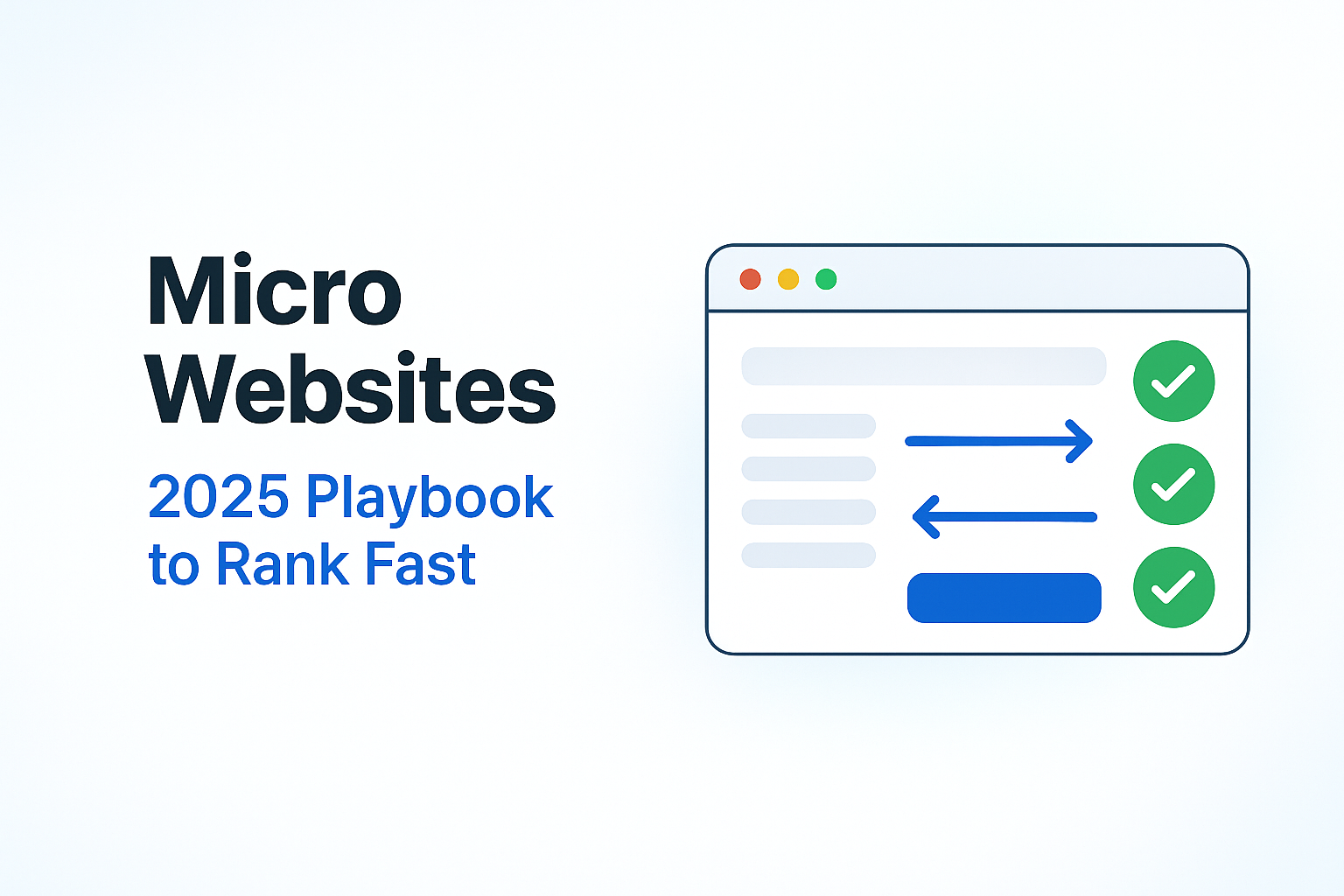
Micro Websites: The 2025 Playbook to Rank Fast (Blueprint, Templates, Examples)
Promise: build small • rank fast • earn predictable income with Micro Websites.
Micro Websites TL;DR
A micro website is a tiny site (5–15 pages) focused on one specific problem with clear search intent.
You win by (1) choosing a winnable topic, (2) publishing intent-matched pages, (3) interlinking like a hub, and
(4) iterating every 14 days on near-wins (rank positions 6–15).
What Are Micro Websites (and why they win now)
Micro Websites (aka microsites) cover a single tiny topic end-to-end.
Unlike broad blogs, they launch in days, avoid content bloat, match intent on every page, and funnel to one clear CTA.
Micro Websites Blueprint (copy this)
| Page | Purpose | Primary CTA | Notes |
|---|---|---|---|
| Home | Promise + who it helps + quick nav | Starter Kit / lead magnet | Link 3–5 pillars |
| Pillar Guide | The what/why/how | Start Guide / Checklist | Jump links |
| Best/Top List | Curated buying help | Affiliate CTAs | Comparison table |
| VS / Alternatives | Mid-funnel decisions | See full comparison | Honest trade-offs |
| How-to / Setup | Hands-on tutorial | Tools page | Screens + steps |
| FAQ | PAA and objections | Internal links | Scannable |
| About | Trust + proof | Starter Kit | Experience + contact |
| Contact | Low-friction message | Response time |
Internal links:
Start here •
Tools we use •
7-day plan •
Micro Website vs Blog •
Best niches
Launch in 4 Steps (IO-4)
Step 1 — Pick a winnable niche
- One core problem + clear buyers (e.g., “Notion budget templates for students”).
- Check the SERP: can you publish better / faster / clearer than the top 5?
- Seed 10–20 keywords: what is, best, vs, for [persona], pricing, setup, mistakes.
Step 2 — Ship the core Pages (5–7)
- One H1 that equals the query; H2/H3 mirror sub-intents.
- One primary CTA per screen.
Step 3 — Interlink your hub
- From each page, link up to the pillar and sideways to 1–3 siblings.
- Use descriptive anchors (not “click here”).
Step 4 — Iterate every 14 days (near-wins)
- Track keywords; sort by positions 6–15.
- Improve intro, add a missing sub-section, a mini table, tighten the CTA, add 1–2 internal links.
SEO That Actually Moves the Needle
- Intent first: write to what the SERP shows (not what you wish it was).
- Scannability: sub-heads every ~150 words, bullets, tables.
- Schema basics: Article + FAQ/HowTo where useful (see below).
- Media: 1200×675 WebP; aim under 180 KB.
- Speed: compressed images, lazy-load, minimal plugins.
Monetization That Doesn’t Annoy Users
- One useful affiliate that truly solves the job; pros/cons + usage tip.
- Tiny product ($9–$29) with a short use-case demo.
- Lead capture → 3-email mini series → soft offer.
Example Micro Websites Map
Topic: Simple Rank Tracking for Beginners
- / — Why small sites should track 20–80 keywords
- /best-simple-rank-tracker/ — Best list
- /rank-tracker-vs-spreadsheet/ — VS page
- /how-to-track-near-wins/ — How-to
- /templates/keyword-tracking-sheet/ — Download/offer
- /faq/ — FAQ
Primary CTA across the set: Get the Micro Website Starter Kit.
On-Page Template (copy)
- Intro: problem → promise → quick proof.
- Blocks: H2, 2–3 short paragraphs, 3–5 bullets, mini CTA.
- Outro: 1-sentence summary + next best click.
Micro Websites vs Blogs (quick table)
| Micro Website | Traditional Blog | |
|---|---|---|
| Scope | Tiny (one job) | Broad (many topics) |
| Time to rank | Fast (weeks) | Slower (months) |
| Maintenance | Low | Higher |
| Conversion | High (1 CTA) | Mixed |
| Best for | Beginners, side projects | Media sites, category leaders |
Deep dive: Micro Website vs Blog
Mistakes That Keep You Stuck at #11
- Writing to yourself, not the SERP intent.
- No VS / Alternatives article.
- Too many CTAs → decision fatigue.
- Weak internal linking.
- Ignoring near-wins (6–15).
Pre-Publish Checks
- One H1 = query; Title ≤ 60 chars; Meta ≤ 155 chars.
- Min. 2 internal links out, 1 internal link in.
- Include a table or checklist.
- WebP images; total page size < 1.2 MB.
- Clear primary CTA above and below the fold.
FAQs
What size should a hero image be?
Use 1200 × 675 (16:9) in WebP, ideally under 180 KB.
How many pages does a Website need?
Start with 5–7 pages, each targeting one intent.
How do I pick a niche?
Choose a small problem with buyer intent where you can publish better/faster than the top results.
See: Best Micro Website Niches.
Your Next Three Actions (today)
- Pick one problem you can truly solve.
- Sketch your 5–7 pages (copy the blueprint table).
- Follow the 7-Day Plan and track near-wins.
